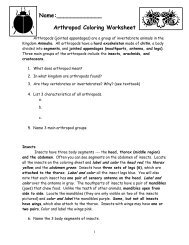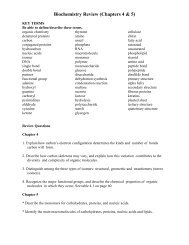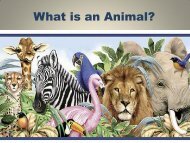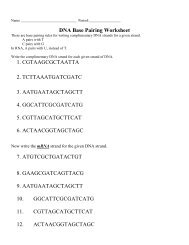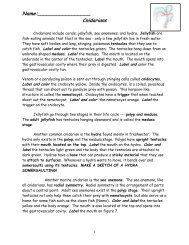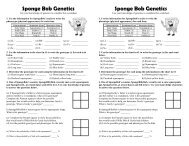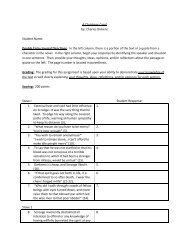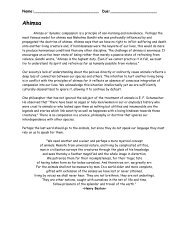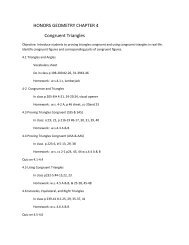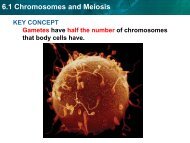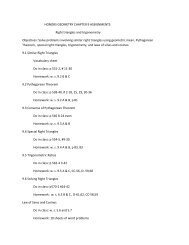10.4 Evidence of Evolution
10.4 Evidence of Evolution
10.4 Evidence of Evolution
Create successful ePaper yourself
Turn your PDF publications into a flip-book with our unique Google optimized e-Paper software.
<strong>10.4</strong> <strong>Evidence</strong> <strong>of</strong> <strong>Evolution</strong><br />
KEY CONCEPT<br />
<strong>Evidence</strong> <strong>of</strong> common ancestry among species comes<br />
from many sources.
<strong>10.4</strong> <strong>Evidence</strong> <strong>of</strong> <strong>Evolution</strong><br />
<strong>Evidence</strong> for evolution in Darwin’s time came from<br />
several sources.<br />
• Fossils provide evidence <strong>of</strong> evolution.<br />
• Fossils in older layers are more primitive than<br />
those in the upper layers.
<strong>10.4</strong> <strong>Evidence</strong> <strong>of</strong> <strong>Evolution</strong><br />
• The study <strong>of</strong> geography provides evidence <strong>of</strong> evolution.<br />
– island species most closely resemble nearest mainland<br />
species<br />
– populations can show variation from one island to<br />
another
<strong>10.4</strong> <strong>Evidence</strong> <strong>of</strong> <strong>Evolution</strong><br />
• Embryology provides evidence <strong>of</strong> evolution.<br />
– identical larvae, different adult body forms<br />
– similar embryos, diverse organisms<br />
Larva<br />
Adult crab<br />
Adult barnacle
Comparative embryology<br />
• Similar embryological development in<br />
closely related species<br />
all vertebrate embryos have similar<br />
structures at different stages <strong>of</strong><br />
development<br />
• gill pouch in fish, frog, snake, birds, human, etc.<br />
AP Biology
AP Biology
<strong>10.4</strong> <strong>Evidence</strong> <strong>of</strong> <strong>Evolution</strong><br />
• The study <strong>of</strong> anatomy provides evidence <strong>of</strong> evolution.<br />
– Homologous structures are similar in structure but<br />
different in function.<br />
– Homologous structures are evidence <strong>of</strong> a common<br />
ancestor.<br />
Human hand<br />
Mole foot<br />
Bat wing
<strong>10.4</strong> <strong>Evidence</strong> <strong>of</strong> <strong>Evolution</strong><br />
• The study <strong>of</strong> anatomy provides evidence <strong>of</strong> evolution.<br />
Human hand<br />
– Analogous structures have a similar function.<br />
Mole foot<br />
– Analogous structures are not evidence <strong>of</strong> a common<br />
ancestor.<br />
Fly wing<br />
Bat wing
<strong>10.4</strong> <strong>Evidence</strong> <strong>of</strong> <strong>Evolution</strong><br />
Structural patterns are clues to the history <strong>of</strong> a species.<br />
• Vestigial structures are remnants <strong>of</strong> organs or structures<br />
that had a function in an early ancestor.<br />
• Ostrich wings are examples <strong>of</strong> vestigial structures.
Vestigial organs<br />
• Hind leg bones on whale fossils<br />
Why would whales<br />
have pelvis & leg bones<br />
if they were always<br />
sea creatures?<br />
AP Biology
<strong>Evolution</strong> is "so overwhelmingly<br />
established that it has become<br />
irrational to call it a theory."<br />
-- Ernst Mayr<br />
What <strong>Evolution</strong> Is<br />
2001<br />
Pr<strong>of</strong>essor Emeritus, <strong>Evolution</strong>ary Biology<br />
Harvard University<br />
(1904-2005)<br />
AP Biology 2007-2008



